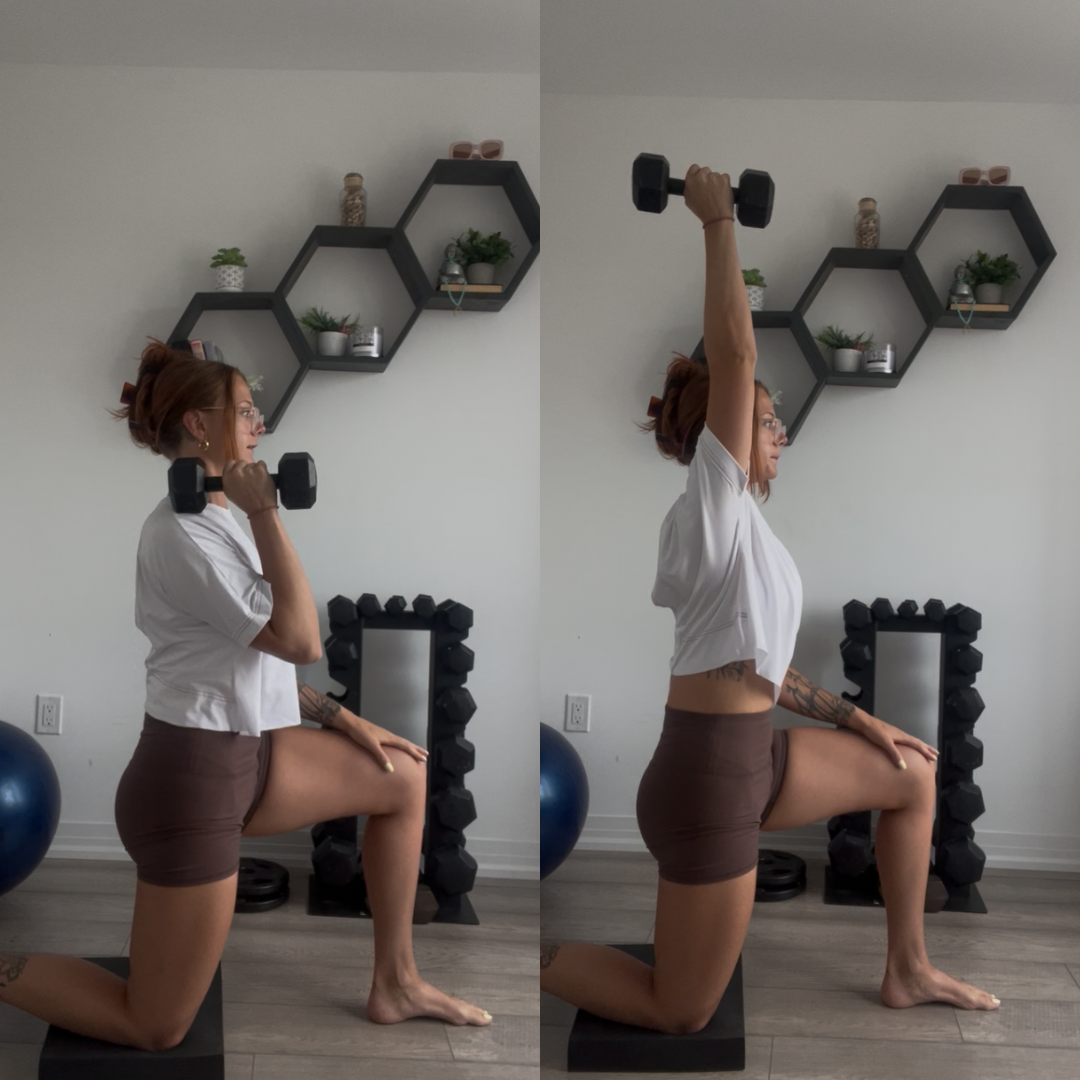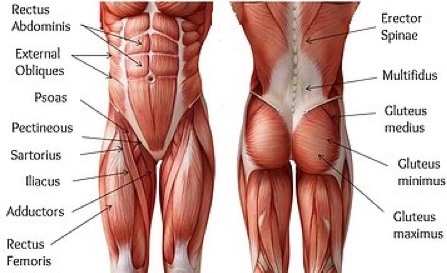Half-Kneeling: The Underrated Core Move
Let’s be honest — most people skip the “weird” positions in a workout.
If it’s not a squat, a press, or something that feels like work right away, it often gets written off as a warm-up drill or rehab exercise. And the half-kneeling position? That’s one of the most overlooked.
But here’s the thing: getting down on one knee can reveal more about your posture, core control, and balance than a heavy barbell ever could. It’s not about lifting the most weight, it’s about how well you can generate force from a less stable base and control movement through your hips and spine. And that translates directly to performance, not just in sport, but in everyday life.
Think about it: how often do you actually use both feet evenly and stand still? Whether you’re walking, reaching, twisting, swinging, hiking, or picking something off the floor, your body is constantly shifting weight, stabilizing through one hip, or resisting rotation. The half-kneeling stance trains you for that.
It’s a position that shows up in sports like hockey, tennis, and baseball — but also in real life when you're gardening, playing with your kids, or hoisting a suitcase out of the car. And yet, most people never train it.
So in this one, we’re breaking down why the half-kneeling position deserves a spot in your routine, how it compares to traditional standing exercises, and how to use both for better strength, balance, and body awareness, no matter your goals.
Why Do We Always Train Standing?
When most people think of strength training, they picture standing on two feet — squatting, pressing, deadlifting. And for good reason. Standing in a bilateral stance is where we’re strongest. You’ve got a wide, stable base, your body can produce more force, and you can move heavier weight with greater efficiency.
But there’s another position that deserves a spot in your training routine, one that challenges your core, improves your posture, and mimics real-life and sport-specific movements.
It’s the half-kneeling position and it’s not just for stretching.
A Quick History Lesson
The half-kneeling position has roots in both physical therapy and athletic development. Originally used as a rehab tool for patients recovering from injury — especially in the hips, spine, or core — it helped retrain the brain to stabilize the body without compensating through poor mechanics.
Over time, strength coaches and movement specialists started using it to correct posture, improve balance, and enhance neuromuscular coordination, especially in athletes.
It became particularly popular in the 2000s with the rise of functional training and systems like the Functional Movement Screen (FMS), where half-kneeling is used to assess lumbo-pelvic control and symmetry. In elite sports settings, it’s been used to help hockey players, baseball players, and golfers generate power without losing spinal alignment or control.
But you don’t need to be an athlete to benefit from it.
Half-kneeling helps anyone who:
Sits for long hours and has tight hip flexors
Struggles with core engagement during standing lifts
Experiences low back pain from poor posture or compensation patterns
Wants to improve balance, trunk control, or rotational strength
In other words, it’s for almost everyone.
This position doesn’t just prepare you for sport — it prepares you for life. Things like tying your shoe, picking up a bag, kneeling to garden, or reaching across your body all mimic the asymmetrical nature of half-kneeling.
So while training in a bilateral stance will always be important for building raw strength, incorporating half-kneeling can help you move better, feel more stable, and build strength where it matters most, in the positions you actually live in.
What Is the Half-Kneeling Position?
Half-kneeling means you’re down on one knee, with the opposite foot planted in front of you, creating a 90–90 angle at both knees — almost like a lunge that you’re holding statically. Your hips should be square, your pelvis neutral, and your torso tall. Your back foot can be either tucked under (to help with stability and engagement) or flat (to reduce tension and increase the stretch in the hip flexors).
It might look like a rest position, but biomechanically, it’s anything but passive.
The Anatomy of Half-Kneeling
What makes this position so powerful is how much it demands from your stabilizing muscles, especially in your core, hips, and shoulders. Because you’re narrowing your base of support and removing symmetry (only one foot on the ground), your body has to work harder to stay aligned, particularly in the frontal and transverse planes.
Here’s what’s happening under the hood:
🔹 Core Muscles
Unlike bilateral standing, where your trunk can rely on a wide base and often use momentum, half-kneeling challenges your:
Obliques (internal and external): prevent side bending and rotation
Rectus abdominis: maintains upright posture
Transverse abdominis: acts like a belt to stabilize your spine
Multifidus & deep spinal stabilizers: help prevent excessive spinal movement
🔹 Hips & Glutes
The glute max and medius are engaged to keep the pelvis level, especially on the front leg
The hip flexors (especially the iliopsoas on the back leg) are being passively stretched — which is crucial for undoing the chronic shortening that happens with sitting
The adductors help resist lateral sway or collapse through the knee or pelvis
🔹 Shoulders & Scapular Stabilizers
When you add an overhead press or a banded resistance (like a Pallof press or anti-rotation hold), your:
Serratus anterior
Lower traps
Rotator cuff muscles
have to stabilize the shoulder joint under load, which is often harder in this position due to the reduced core support and need for precise alignment.
How Half-Kneeling Differs from Standing
In a standing bilateral position, your body is more symmetrical and stable. That allows for greater force production, meaning you can move more weight, but you’re also more likely to compensate with your stronger side, rely on momentum, or avoid engaging smaller stabilizers.
In half-kneeling, the opposite happens:
Your center of gravity shifts
Your base is narrower, creating an unstable environment
You can't use momentum — you have to own every part of the movement
This forces your neuromuscular system to become more efficient, leading to improved coordination, proprioception (body awareness), and even reflexive core activation.
The Science Says…
A 2018 EMG (electromyography) analysis published in the Journal of Strength and Conditioning Research showed that core muscle activation — especially of the obliques and deep transverse abdominis — was significantly higher in half-kneeling Pallof presses compared to standing or seated variations. The researchers noted improved lumbopelvic control and rotational stability, both key indicators of functional core strength.
So while it might look like you're just "taking a knee," the half-kneeling position lights up your stabilizers, teaches your brain better body control, and strengthens the muscles that help you resist unwanted movement — which is what true functional strength is all about.
The Hidden Benefits of Half-Kneeling
Core Activation A 2021 study in the Journal of Strength and Conditioning Research found that exercises performed in a half-kneeling stance result in greater core muscle activation than those done in a traditional standing position. This is especially true when the movement involves rotation or anti-rotation (like chops or Pallof presses).
Improved Postural Control Half-kneeling reduces your base of support and removes the ability to cheat with momentum. Your obliques, glutes, and deep stabilizers have to work in unison to keep your pelvis stacked and ribcage aligned.
Unilateral Hip Stability This position creates asymmetrical demand on your hips. The forward leg works on stability and balance, while the back hip stretches and stabilizes. It’s great for retraining the brain-body connection if you’ve had past injuries or spend most of your day sitting.
Translates to Sport & Life Many sports involve one-leg-forward stances — think baseball swings, slapshots in hockey, tennis serves, or even hiking on uneven terrain. The half-kneeling stance teaches you to generate force from the ground up while resisting unwanted movement — especially in the torso.
Bilateral Standing vs. Half-Kneeling: When to Use Each
Each stance serves a different purpose, and knowing when to use them can elevate your training from just going through the motions to actually building smarter, more functional strength.
Think of bilateral standing movements as your main course — essential for foundational strength and muscle gain. Half-kneeling work? That’s your secret sauce — the thing that enhances how everything else works together.
Sample Workout: Standing + Half-Kneeling Across All Planes of Motion
This full-body session combines strength, stability, and core control while intentionally targeting the sagittal, frontal, and transverse planes — giving you a well-rounded approach that carries over to real life and sport.
🔹 Block A – Strength & Stability
Build foundational strength with added core challenge
Goblet Squat – 3x8 → Trains legs and core through forward/back movement.
Half-Kneeling Landmine Press (1-arm) – 3x10/side → Builds shoulder strength and teaches trunk control under rotation and press.
🔹 Block B – Lateral & Anti-Rotation Control
Challenge stability through side-to-side and resisting movement
Lateral Step-Up – 3x8/leg → Strengthens glutes and adductors while challenging frontal-plane balance.
Half-Kneeling Pallof Press – 3x12/side → Targets obliques, core, and posture by resisting rotation.
🔹 Block C – Conditioning & Integration
Tie everything together with posture and carryover to movement
Farmer Carry (1-arm) – 3x30s/side → Builds trunk stiffness, grip, and total-body endurance while resisting lateral flexion.
Half-Kneeling Overhead Dumbbell Hold + Rotation – 3x20s/side → Teaches bracing through the spine and hips while moving through rotation.
It’s easy to overlook the value of simple positions when they don’t feel flashy or “hard enough.” But sometimes, the exercises that look easy are the ones that reveal the most about how your body actually functions.
The half-kneeling stance is one of those. It forces you to slow down, dial in your alignment, and challenge your core in ways standing simply doesn’t. It strengthens the connection between your hips, spine, and shoulders, the parts of your body that are responsible for nearly every movement you make, from walking uphill to carrying groceries to swinging a golf club.
And the best part? You don’t need a full gym, fancy equipment, or even a ton of time to benefit from it. Just a pair of dumbbells, a resistance band, and a bit of intention.
So whether you’re training for strength, injury prevention, or just to feel more balanced in your everyday life, don’t skip the basics. Drop into a split stance, build real stability, and see how it changes the way your entire body moves.
Because strong isn’t just how much you can lift.
It’s how well you can control it.
Hope that helps,
Happy Exercising!
Robyn
References
Behm, D. G., & Colado, J. C. (2012). Instability resistance training across the exercise continuum. Sports Health, 4(6), 475–480. https://doi.org/10.1177/1941738112456280
Comfort, P., et al. (2011). A comparison of axial loading and core stability exercises. Journal of Strength and Conditioning Research, 25(6), 1708–1715. https://doi.org/10.1519/JSC.0b013e3181e06ee6
Anderson, K., & Behm, D. G. (2005). Trunk muscle activity increases with unstable squat movements. Canadian Journal of Applied Physiology, 30(1), 33–45. https://doi.org/10.1139/h05-103
Hibbs, A. E., et al. (2008). Optimizing performance by improving core stability and core strength. Sports Medicine, 38(12), 995–1008. https://doi.org/10.2165/00007256-200838120-00004
Kibler, W. B., Press, J., & Sciascia, A. (2006). The role of core stability in athletic function. Sports Medicine, 36(3), 189–198. https://doi.org/10.2165/00007256-200636030-00001



